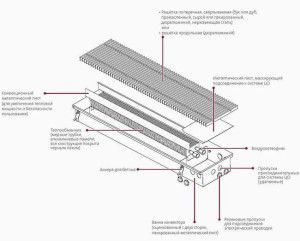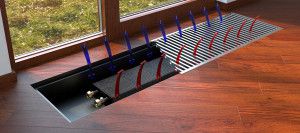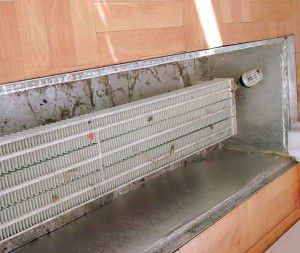One of the disadvantages of classical heating is the appearance of radiators. They will not always look harmonious in the room, and occupy useful space. Therefore, in some cases, they prefer to install other heat supply devices. To make rational and practical floor heating in an apartment and a house is possible with the help of certain schemes, pipes and convectors.
Advantages and disadvantages of underfloor heating
This water heating of the floor in the apartment differs from the standard design and installation methods of radiators. Their heating surface is located below the level of the finishing floor. For convection of air currents, the upper plane of the heat supply device has a grate.
All hot water lines are also hidden under the floor. In fact, the user sees only the upper grille. Through it, air is heated. There are also differences in design.
The convector heating in the floor has an oblong shape. The tubes through which the coolant flows are connected to the housing using heat transfer plates. Most often they are made of copper.
Properly installed water heating of the floor with your own hands should have the following advantages:
- Minimum occupied space. Unlike batteries, the entire room remains free;
- Creating a thermal air curtain. To reduce heat loss, water heating of the floor in the house is equipped with window structures and external walls. Radiators heat air in places of the lowest temperatures;
- Good appearance. In fact, water heating floors in a private house will look harmonious in any interior.
The disadvantages include the uneven distribution of heat. Such systems are not recommended for installation in rooms with a large area. To achieve the optimum effect, a radiator built into the floor should have a fan to increase air convection. This affects the overall noise background. Be sure to install thermostats and programmers for automatic control of the system.
Analyzing reviews about the flooding of the floor, we can conclude that it is a source of dust concentration. Therefore, for this type of heat supply, it is necessary to carry out wet cleaning more often.
Types of floor heating convectors
At the first stage of designing, it is necessary to choose the right radiator built into the floor. They differ not only in standard power characteristics, but also in design. Material of manufacture is also important.
First, the calculation of the required power is performed. The basis is the heat loss in a house or apartment. Then the optimal model of the convector heating in the floor is selected.
It must have the required performance characteristics - withstand the nominal pressure and temperature of hot water.
For installation, you need to do the preparatory work with a rough coating. Effective floor heating with your own hands is done only after warming the rough surface.
The choice of wiring diagram largely depends on the design of floor radiators. They are of the following types:
- Outdoore. Located directly on the surface. The advantage is the easy connection of the underfloor heating to the heating system. Pipes can be placed on top of the wall. The disadvantage is an unsatisfactory appearance;
- Recessed. They are mounted directly on the floor on a rough surface. Only the grating remains in the visible region. The installation of floor heating is complicated, as this leads not only to a decrease in the height in the room, but also to the mandatory adaptation of the materials used to high temperatures.
Floor water heating schemes in an apartment with wall models are not considered. They are no different from the standard and have the same properties.
To increase the degree of convection, a fan can be included in the package. This will improve the uniform thermal distribution throughout the room. However, the cost of such models differs upwards.
Currently, there are a number of manufacturers whose products are suitable for water-based floor heating with their own hands. First of all, the convectors of the German company Kampmann should be highlighted. Depending on the required parameters, models of heating convectors embedded in the floor can have two or three pipes. In the latter case, the rated power of the device increases.
Equally good operational properties are possessed by models of heating radiators built into the floor from the Polish company Verano, Czech Minib and German Kermi. To organize budget heating in the floor with your own hands, you can consider the products of the Ukrainian company Teplobrend and Carrera.
An additional function of water heating floors in a private house may be cooling in the summer. This requires a connection to the chiller system.
Floor heating circuits
Choosing the optimal model of a heating radiator built into the floor, you can begin to draw up a diagram of its installation. At this stage, it is important to consider its operational and technical features.
Heating schemes for laying floor heating practically do not differ from standard ones. The difference lies in the choice of installation method for pipes and radiators. They must be hidden under the floor. Therefore, it is necessary to pre-select the material for the floor - insulation, substrate and decorative surface.
When choosing a scheme, the following factors are taken into account:
- Height of heat convectorsthat will be built into the floor;
- Pipe Material. Polymer must not be installed in concrete screed. Their thermal expansion can tell on the integrity of the highway. For installation, special sleeves are required;
- Revision hatches. After connecting the heated water floor to the heating system to the places of joining of pipelines, free access is provided. This is necessary for repair and maintenance work;
- Installation of air valves, Mayevsky taps and temperature controllers. The most difficult thing is to provide access to these heat supply elements. The scheme of water heating floors in a private house should take this factor into account.
Most often, the choice stops at a closed two-pipe heat supply. It will ensure a normal temperature distribution and is most optimal from the point of view of the complexity of installation and selection of components.
To connect the copper pipes of the heating radiators built into the floor with polymer pipes, special adapters are needed. Contact of copper with other metals can lead to oxidation of the junction.
Installation of floor heating convectors
Correct installation of duct convectors is preceded by preparatory work with the floor. It is necessary to make a niche where heating appliances will be installed. This is best done at the repair stage.
The dimensions of the niche should be 5-10 cm larger than the dimensions of the heating device. This is necessary for the normal connection of the heat supply radiator after it is installed in the floor. Additionally, a thermal insulation layer is mounted. To protect the decorative surface, it is recommended to form a niche using concrete pouring.
At this stage, pipes should be installed in order to further connect to the radiator. Their installation is carried out in the floor, possible thermal expansion is taken into account. For long sections of the highway, installation of compensating heat loops is necessary.
Further installation steps are as follows.
- Installation of heat-reflecting material. This will help improve convection and reduce heat loss.
- Installing a heating convector pallet in the floor. If there is none, a substrate is made of heat-resistant material. The radiator should not hang.
- Connection of branch pipes to the heating system. It is important to select the adapter sleeves correctly to ensure a reliable and durable connection.
- Installation of decorative grilles.
After the final installation of floor heating, a trial run of the system is done. It is first necessary to perform its crimping. Raise the coolant temperature gradually. The same goes for pressure. At this stage, the absence of leaks in the water heating supply of the floor with your own hands is monitored, the operating modes of thermostats are established.
One of the common mistakes when installing convectors without a pallet is filling a niche with construction foam. Its pressure can lead to deformation of the structure.
Features of operating underfloor heating
Before each heating season, the integrity of the system components must be checked. Almost all reviews of floor heating indicate a large amount of dust and dirt in niches. They should be cleaned periodically.
During operation, the temperature controller may change. Since it will be hidden behind a decorative lattice - it is necessary to check its condition. Otherwise, the probability of incorrect operation of the system will increase. In addition, the integrity of the connection of a water heated floor to the heating system is controlled. In such schemes, it is difficult to control the appearance of leaks.
In models with a fan, the power line is laid in advance. To improve comfort, it is recommended to make a remote switch. Clogged fan rotor is also common. It must be cleaned before each heating season.
In the video footage, an example of installing a channel convector in an apartment:







